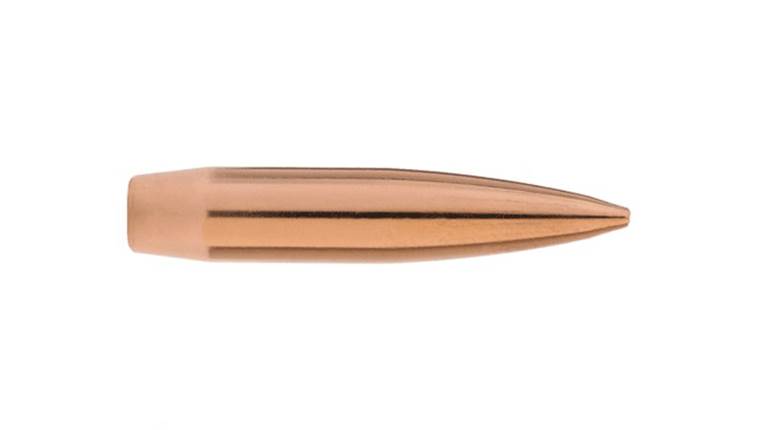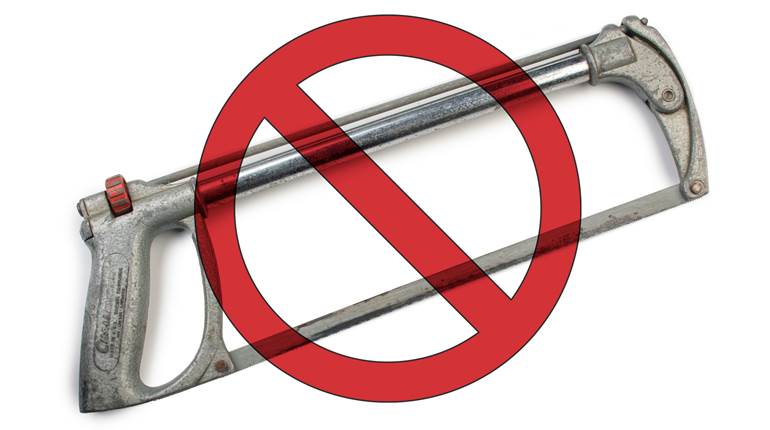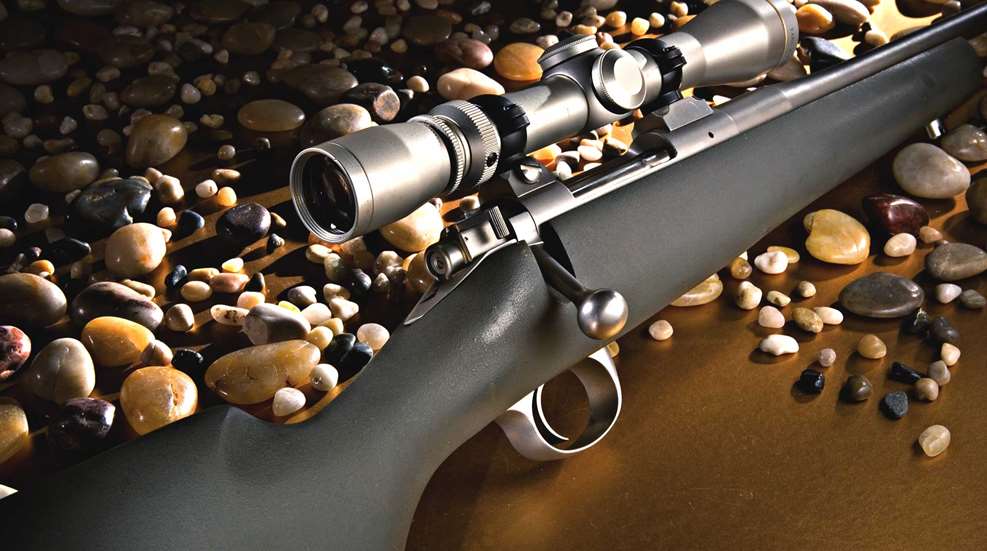
This article, "A Montana In Africa," appeared originally in the July 2005 issue of American Rifleman. To subscribe to the magazine, visit the NRA membership page here and select American Rifleman as your member magazine. Note: Today, Kimber America maintains its stable of Model 84M Montana bolt-actions, now with a few updated features.
“Where are your sticks?” asked Jamy Traut, my professional hunter, as we crept through the tall Namibian grass toward a small herd of red hartebeest.
“In the truck. Danny drove off with them,” I whispered back, speaking of the other P.H., Danny Bartlett, who had left us as we began our stalk, which became a crawl on a particularly nice bull. It wasn’t Danny’s fault; it was mine.
“Backpack?” Jamy asked hopefully.
“With Danny,” I replied with the shame of my own forgetfulness.
The grass was just too tall to shoot prone, yet we might spook the closest hartebeest, about 60 yards from us, if I rose to kneeling. After crawling several hundred yards, I was unwilling to give up on the fine bull that was a mere 250 yards away.
“Well, it is a long way—use my shoulder,” said Jamy with abject confidence. “It will give you the height you need.”
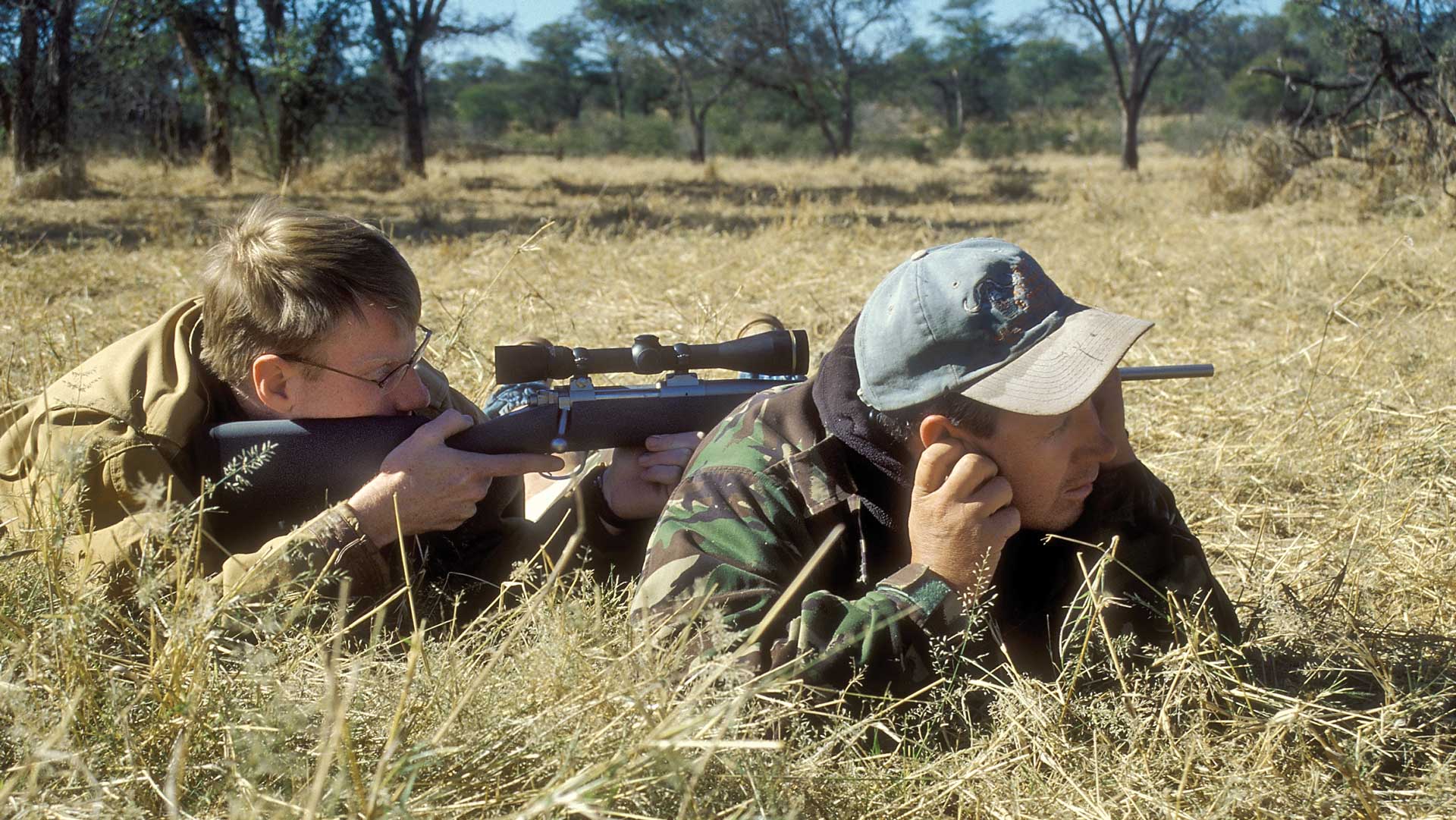
I knew this was common practice with African professional hunters (with clients they trust), but it was not a practice with which I was familiar. So, like a German machine gunner in a World War II newsreel, I laid my fore-end across Jamy’s trusting shoulder. I synchronized my breathing with his as quickly as I could, and the Kimber Montana in .308 Win. barked. The hartebeest began running awkwardly, and I kept it in the scope as I worked the bolt and fired again. At the second shot, he stopped and dropped. Both 168-gr. Barnes Triple Shocks had punched right through. The second was unnecessary—it hit a mere 4" back from the first, which had gone through both shoulders—but I was taught to keep shooting until the animal goes down, so I did.
A Tough Act To Follow
I was at Eden in northwestern Namibia—a magical place to hunt—with my friends from Kimber, Leupold and Guns & Ammo. It was day five of a seven-day plains game safari during which we sought sable, kudu, waterbuck, warthog, impala, gemsbok, zebra, red hartebeest, eland and blue wildebeest.
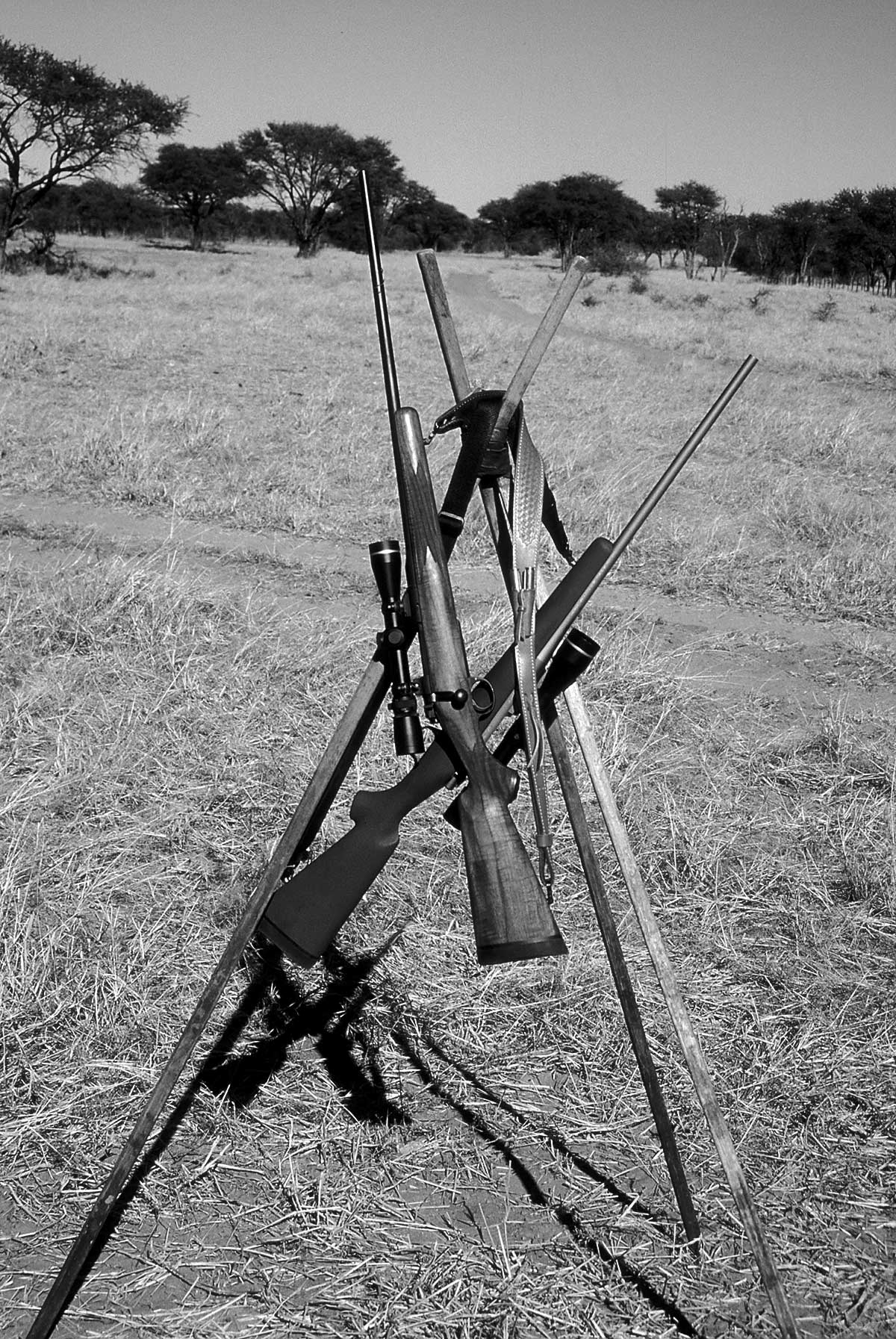
My equipment was a bit different from that of my companions. The rest of the party was using a .300 WSM Model 8400 Kimber, the same rifle NRA Editorial Director John Zent had taken to the same place in 2003. He reported on it in the July 2004 American Rifleman, so I asked Kimber to send me a synthetic-stocked Kimber Model 84M Montana in .308 Win., since it was a rifle we hadn’t yet evaluated. I also took along a blued and walnut .300 WSM Model 8400 rifle (one in stainless and synthetic is offered) fitted with a Leupold 3-9X Vari-X III with the Boone & Crockett reticle.
Function Over Form
For years I have resisted the stainless and synthetic trend in bolt-action rifles. When it comes to my own rifles, I’m really a “blued-steel-and-walnut” kind of guy. Sure, this gun genre, pioneered by Browning’s Stainless Stalker, makes for a quite useful and utilitarian tool. They are well suited to Alaska, Africa and other inhospitable places. I have tested and shot many of them over the years but, regardless of how well they shot, they always went back to their makers—until this one. The Kimber Model 84M Montana in .308 Win. stole my heart with its graceful lines and outstanding performance.

Kimber’s signature walnut and blued steel Model 84M is an elegant, graceful center-fire sporter built around the .308 Win. cartridge. It’s as classic and traditional as a bolt-action rifle can get. But there are some brutal places where elegant bluing and fancy walnut just don’t belong. For those, there’s the Model 84M Montana, a gun that combines the grace and handling of its blue and walnut cousin with the weather
resistance of stainless and synthetic.
The 84M was conceived and designed specifically as a short action by Kimber’s Nehemia Sirkis. The CNC-machined, cylindrical receiver starts out as stainless steel bar stock that finally measures 1.13" in diameter and a mere 7.6" long. The bolt diameter is scaled-down to 0.58". It’s a cylindrical, two-lug design with an external, Mauser-style claw extractor. This makes the 84M Montana a controlled-round-feed gun, as the extractor controls the cartridge from presentation out of the stock’s five-round-capacity blind magazine all the way through ejection.
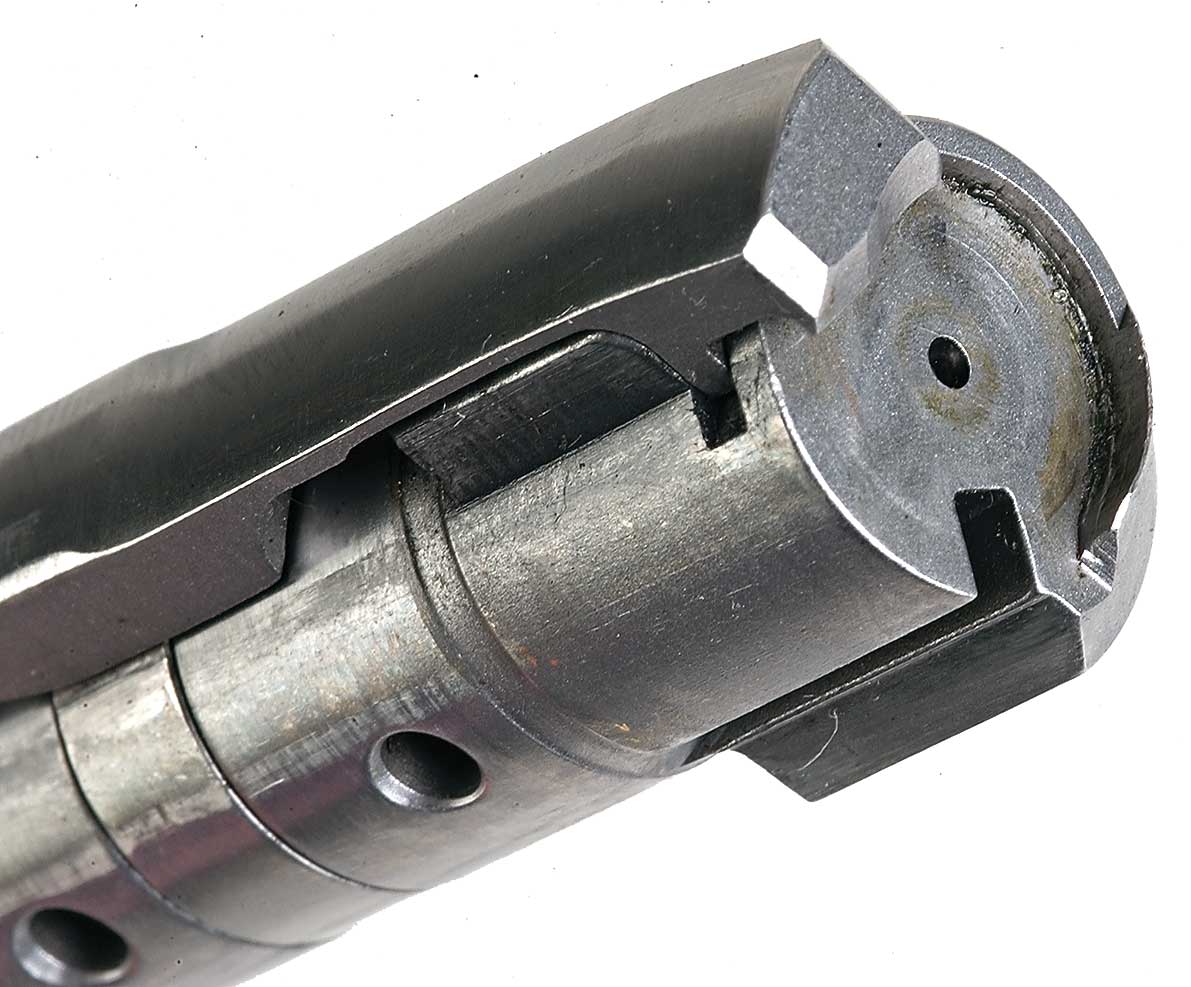
The bolt lugs ride rails cut in both sides of the receiver’s interior that reduce binding or wobble during its cycling. Bolt operation is slick and smooth with no rattling or galling. The ejector is pinned in the bottom left of the receiver behind the ejection port. The three-position, firing-pin-blocking safety on the bolt shroud resembles that of the venerable Model 70. When in the forward or “off” position, a recessed red dot is revealed on the shroud.
The stainless steel barrel is 22" long with a light sporter contour that tapers from 1.04" forward of the receiver ring to 0.55" at the muzzle. It is button-rifled with six grooves and a 1:10" right-hand twist. A dished, recessed muzzle crown protects the rifling’s origin. The recoil lug is a separate component mounted between the barrel and receiver during assembly that engages a bedded recess in the stock. The barrel is not free-floated, but the two stock screws are pillar-bedded using cylindrical aluminum pillars. Engagement surfaces in the stock for the recoil lug and the bottom of the receiver are glass-bedded at the factory.

But it’s the stock that sets the Montana apart. In general, it has the American lines of the walnut 84M, and its rounded fore-end tapers gently to the front of the magazine well. There is a bit of shadbelly to its bottom at the magazine to accommodate the five .308 Win. cartridges. Remember, the Montana has a blind magazine, so there is no floorplate. The stock has a slightly rough finish and its gray exterior paint makes it resistant to slipping in the hands. The butt is topped by a 1" Pachmayr Decelerator pad.
The Montana is an extremely accurate production rifle. From the bench I was able to turn in slowly fired five-shot groups with Barnes X-Bullet Triple Shock handloads that grouped into 0.61" at 100 yards. With Federal 165-grain and Winchester 168-grain factory loads it shot five-shot groups of 0.86" and 0.97", respectively, at 100 yards. Needless to say from Namibia to Fairfax with hundreds of rounds downrange for practice and with several at game, there were no failures of any kind.
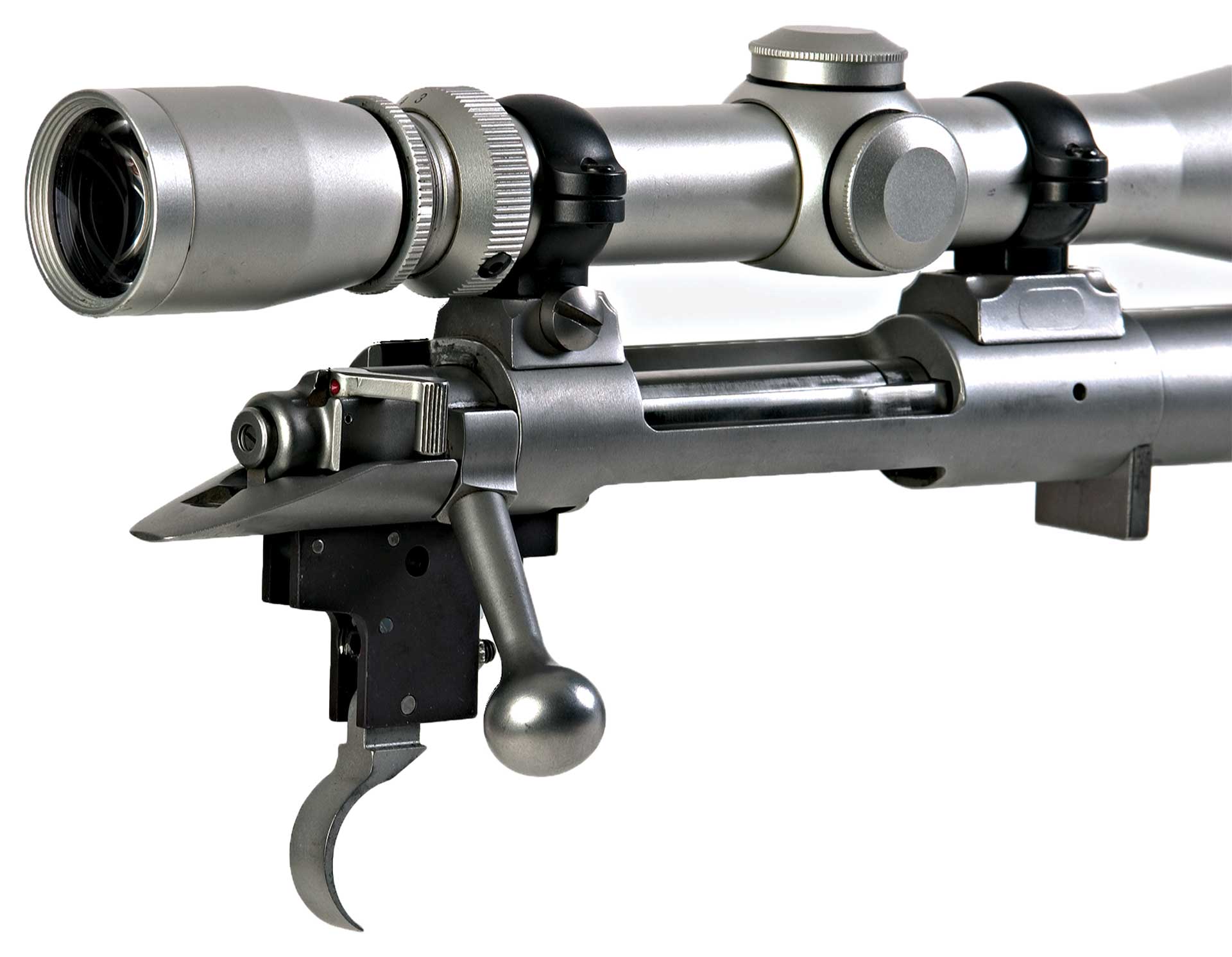
The Kimber Montana is ergonomically a dream. It came to the shoulder naturally and never once afield did I fail to appreciate its scoped and loaded 6 1⁄4-lb. weight. When others slung their rifles on a long stalk, mine remained in the hands.
Manufacturer: Kimber Mfg., Inc.
Chambering: .308 Win.
Action Type: bolt-action, centerfire, repeating rifle
Recevier: stainless steel
Finish: matte stainless
Magazine: integral, blind, five-round capacity
Overall Length: 41.5"
Barrel: 22" light sporter contour, threaded
Rifling: button rifled, four-groove, 1:12" RH twist
Weight: 5 lbs., 9 ozs. (empty, unscoped)
Sights: none, drilled and tapped for Kimber scope bases
Trigger Pull: single-stage, adjustable, 33⁄4 lbs.
Stock: synthetic: length of pull, 135⁄8"; drop at heel, 9/16"; drop at comb, 7/16"
MSRP: $1,522
On Game
Over the course of our trip, I took a zebra at 200 yds. on the first day (which actually required a follow-up shot because I placed the bullet about 3" too far back), an impala at 230 yards, a warthog at 130 yards, a gemsbok at 40 yards, a blue wildebeest at 150 yards, the aforementioned red hartebeest and the kudu that was part of the Namibian double.
The rifle’s accuracy and handling were an integral part of making this the most successful and enjoyable hunt of my life and career. My friends in camp and at Eden, of course, were the icing on the cake. But for this
traditionalist rifleman, my hunting experience with a rifle named for Big Sky country couldn’t have been more rewarding.
Light & Heavy
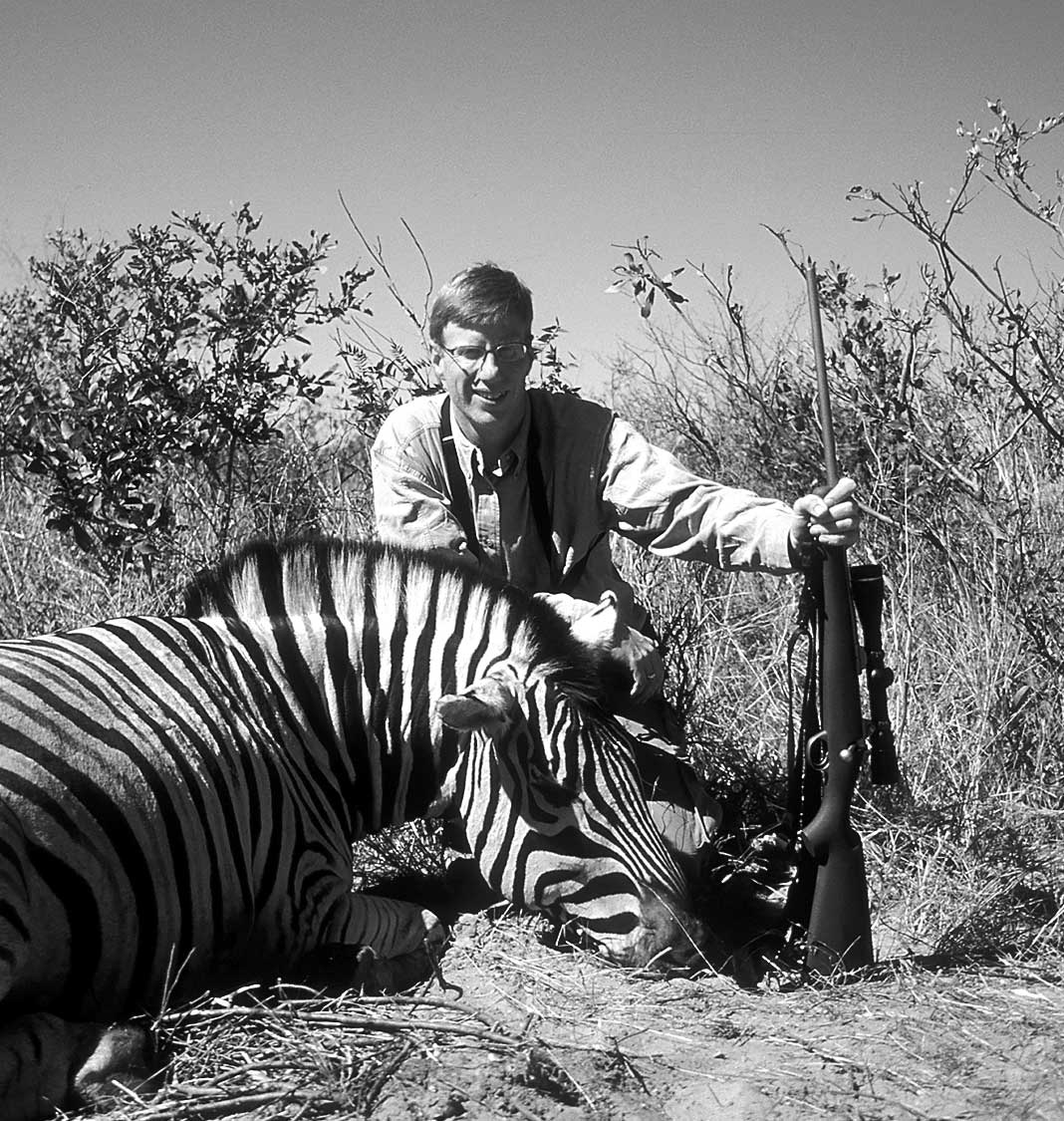
For the larger African antelope, many advise that a .308 Win. is not enough gun. I would agree in many cases, but if you have an accurate rifle a tough bullet and confidence in both (and yourself), you can do just fine. Shot placement is the key. Even with a tough bullet, such as the Barnes-X Triple Shock, you must be very sure of your shot because the light bullet gives you less margin for error.
I used the new 168-grain Barnes Triple Shock, solid-copper boattail bullet in a handload prepared by Kimber’s Barry Vanderstouw. Barry has applied several benchrest techniques to his handloads that increase accuracy with no compromise in functional reliability. The Triple Shock functions much like an X-Bullet, however it has three driving bands (like on a cannon shell) at its base to prevent some pressure issues that some claim to have experienced with the standard X-Bullet. The sectional density on the 168-grain .308 Triple Shock is 0.253, and the ballistic coefficient is 0.476.
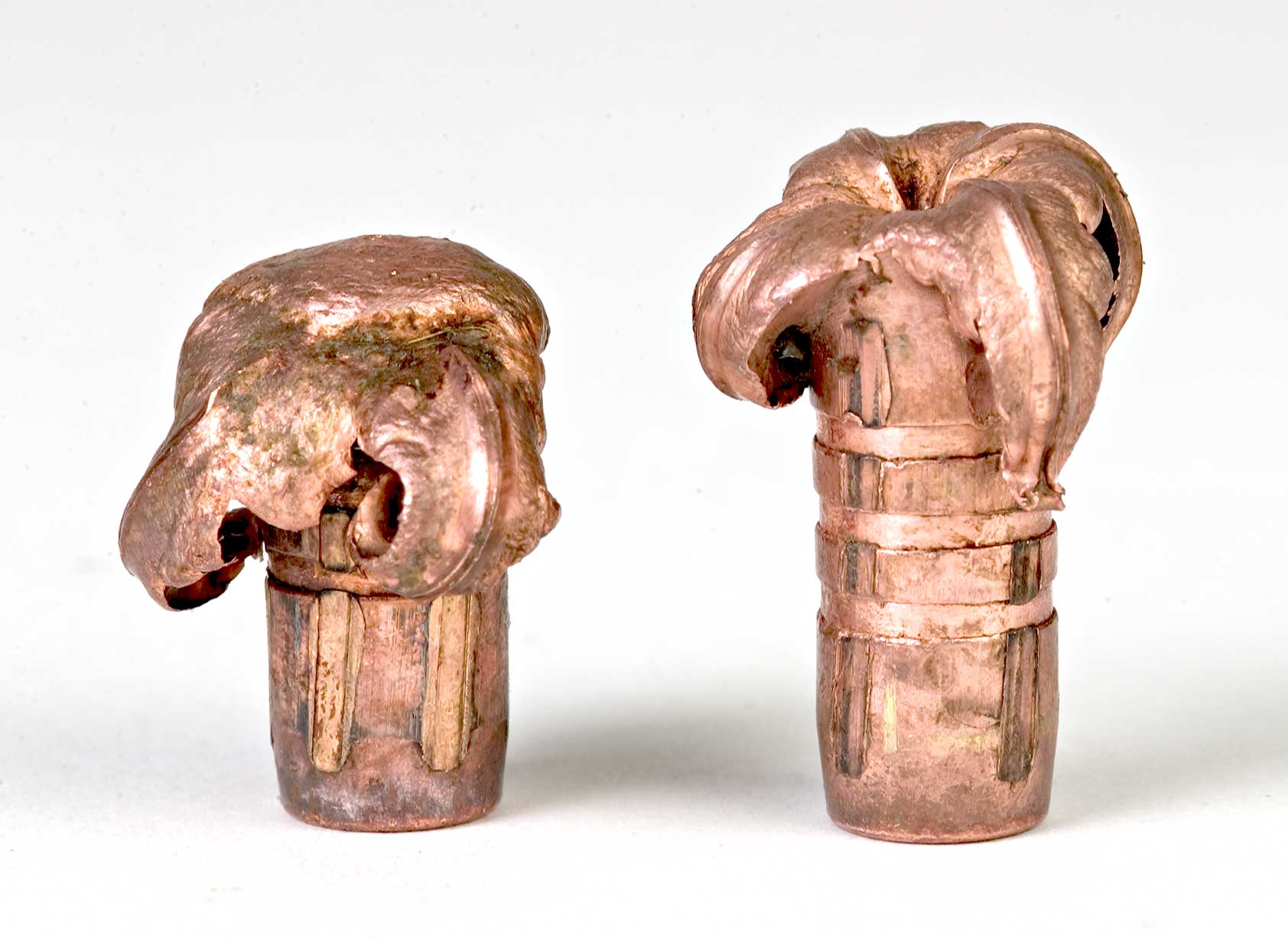
Only two bullets were recovered, everything else passed clean through. On a finishing shot on my zebra, the bullet entered the left rear hindquarter, busted through bone and lodged in the front shoulder. The 0.308", 168-gr. bullet expanded to 0.683" and retained all its original weight. Hitting all that bone actually folded one petal in on the core. The second recovered Triple Shock entered my kudu at the right front shoulder at 80 yards and was
recovered from the hindquarters.
It, too, retained all its original weight and expanded to 0.631" and ended up looking like something out of a Barnes catalog. With its deep-penetration, accuracy and weight retention,
the Triple Shock may be the best Barnes yet.
The Namibian Double ... And A Brush Lesson
Much of the hunting at Eden consisted of riding in a Land Cruiser and spotting and stalking game or sitting patiently in a blind observing an almost Noah’s Ark-like cavalcade of African species. It was during the former that tracker Jonah, P.H. Jamy Traut, Mike Slack and I saw a kudu several hundred yards away cross a dirt track.
“He’s a nice one that,” said Jamy, and we set off on foot to find him. Jamy and Jonah kept us on his spoor (sign) and we followed the kudu through several hundred yards of thick brush. At one point we lost him, and Jonah climbed a thornbush atop a low hill to see if he could spot him. Jonah grinned and held up two fingers as he descended.
“Two kudu,” he said.
We stalked through the thick stuff and came across a bull with massive spiral horns standing broadside to us at about 80 yds. away partly obscured by brush. I dialed down my scope to 2.5X and slipped my left elbow through the Ching sling as we maneuvered for a clear shot.
“He’s a nice one, shoot when you are ready,” said Jamy.
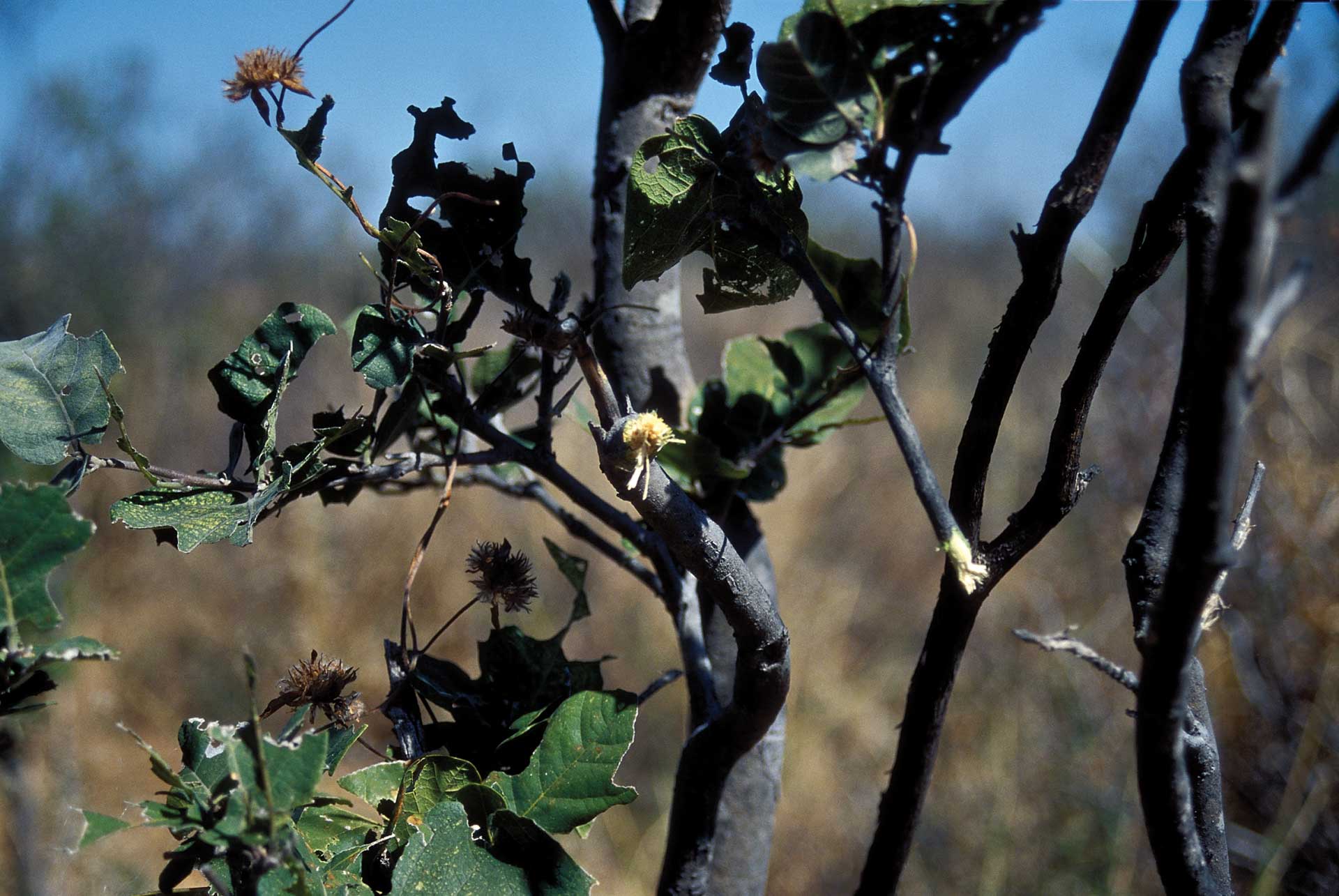
The gun came up, my breathing stopped, and the crosshair danced ever so slowly then settled on the animal’s heart. The shot broke, the gun fired, an odd noise pierced my ears after the shot and … nothing. It just stood there. I racked the bolt quickly, put the crosshairs where they belonged and fired again. Bwee! Again, nothing.
I’m a pretty good rifleman, and it was not a difficult shot. I was as perplexed as I have ever been. As I racked the bolt the third time Jamy—standing immediately to my left watching the seemingly bulletproof kudu look back at us—looked as confused as I did. After the fact he said the look on my face said “What is going on here?” and he almost laughed, which we did a lot of later.
The third round sang out, and the kudu a nice older, 56" bull, fell in his tracks. As we approached the magnificent animal, the reason for the misses and the odd sounds was pointed out to me by Jonah. About 70 yards from me—and a mere 10 yards from the kudu—were two broken branches, twigs really, within inches of each other. Invisible to me in the scope, they had deflected the first two shots. Even tough bullets like the Barnes X are not immune to deflection.
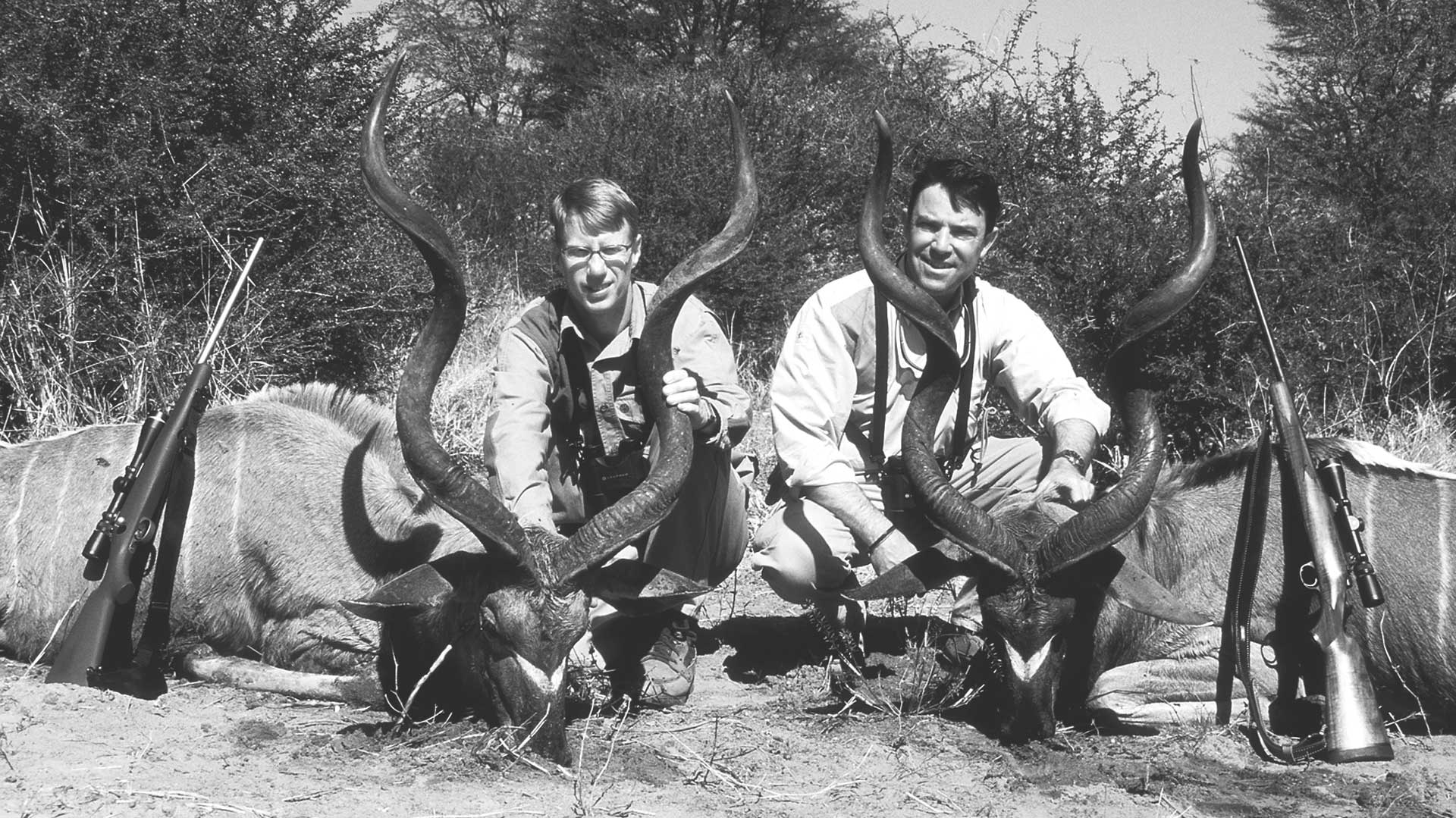
Minutes after I took my kudu, Mike Slack took another even finer—the second of the two fingers Jonah had held up—with a fine, quick off-hand shot from his Model 8400 in .300 WSM. Indeed, it was a “Namibian double,” and a blow to the myth of “brush busting”.
A Place Aptly Named
Covering nearly 70,000 acres, Eden is arguably the finest place in which to hunt in northwestern Namibia. Eden was formerly eight cattle ranches, but in the 1970s owner Leon Jooste’s family decided to allow the native game species to return and thrive, and he has used very sound wildlife management practices in reintroducing those that were not present.
On the Eden Wildlife Sanctuary you will find sable, giraffe, kudu, eland, springbok, gemsbok, red hartebeest, blue and black wildebeest, warthog, impala, cheetah and leopard. Eden, again for conservation sake, also has reintroduced elephant and black rhino, which are doing well there but are not hunted. Hunting concentrates on taking older trophy animals. Surplus game animals are often transplanted from Eden to game parks and other ecological operations.
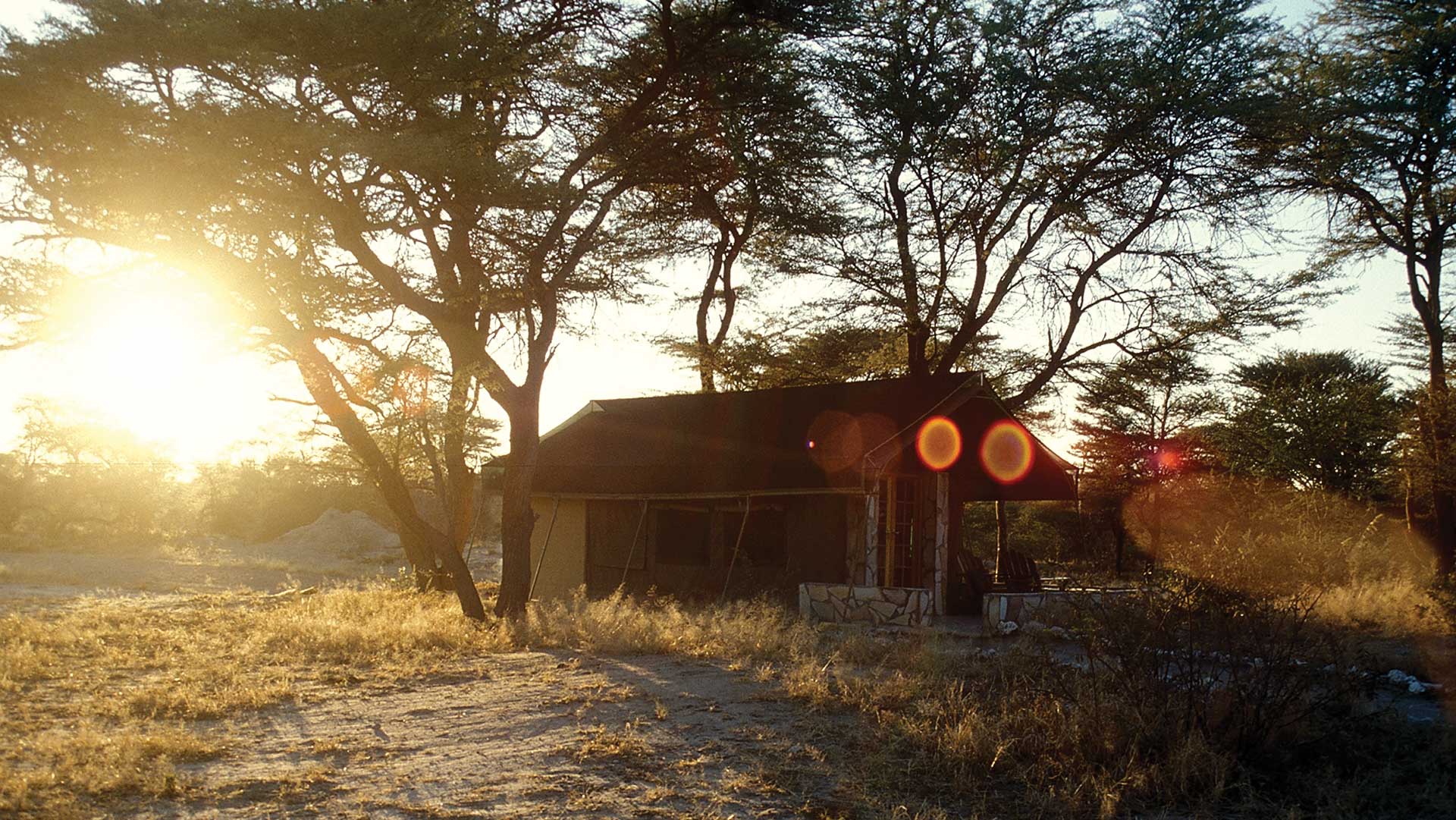
Jamy Traut manages the hunting, fishing and tourist operations, and also serves as the chief professional hunter. His love and enthusiasm for hunting, the land and the game are infectious. The other professional hunter in camp was Danny Bartlett, one of the most famous professional hunters in Namibia and a man with more than 100 elephant safaris under his belt.
Eden’s accommodations were as fine as one could reasonably ask for in the bush. The lodge was elegant but natural with its use of local stone and thatch. Creature comforts included wood-fired showers, a private bath, a small swimming pool and a campfire circle that, in the evenings, was almost as fun as the hunting. The trackers, Kamati and Jonah, were first-rate, as was the food (with the exception of the ostrich neck) and the excellent wine from Leon’s vineyard. In the near future, Eden may offer opportunities to hunt some of the “big five” in the Caprivi strip, greatly expanding the hunting opportunities available.
For more information, contact Jack Atcheson & Sons, Inc. at atcheson.com.












